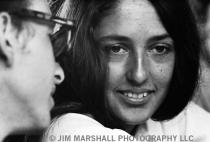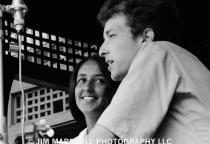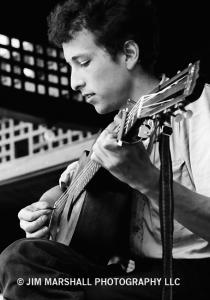You can’t talk about Bob Dylan’s early career without acknowledging Joan Baez’ catalytic effect on his work, his outlook and his emotions. They met at Gerde’s Folk City in Greenwich Village in 1961 when Baez (Joanie as Jim called her) was on tour. The 20-year-old Baez was already a big star on the folk scene; Dylan, the same age, was just a compelling wannabe.
But the erudite Baez, already considered the “Queen of Folk,” seems to have immediately recognized his unique gifts as a lyricist and was, by all accounts, extraordinarily generous in opening doors, recording his songs and letting Dylan perform with her, even when the audience was all about her and none too thrilled about the scrawny, nasal-toned, poor man’s Pete Seeger/Woody Guthrie that Dylan was typecast as at the time.
And, even though Joan found him to be a somewhat unappetizing “urban hillbilly” and Dylan was supposedly more into Joan’s baby sister Mimi, who apparently did not return the affection, it wasn’t long before Joan and Bob were romantically involved. The Queen now had a King, even if he wasn’t such a prince of a guy -- at the time it may have even been somewhat of a scandal as Dylan and Suze Rotolo hadn’t really broken it off.
There’s a 2009 PBS American Masters documentary on Joan that features a lovely assortment of images that attest to Jim’s own lifelong love affair with Baez (unconsummated) and also captures the Dylan and Baez romance “Joan Baez: How Sweet the Sound” but in my opinion if you want still images of this mutual admiration society, look no farther than Jim’s lovely fly-on-the-wall images of Baez and Dylan at the Newport Folk Festival in 1963, seen here for the first time.
Positively in Love
For another great resource to learn more about this crucial early ’60s Greenwich Village incubator that nurtured some of the most powerful collaborations in music, culture and politics, check out David Hajdu’s “Positively 4th Street: The Lives and Times of Joan Baez, Bob Dylan, Mimi Baez Farina and Richard Farina.”
Once again, I find myself feeling that any words of mine pale in comparison to those of the people who inspired Jim’s passionate eye. Instead, I will leave you with the artist’s work. Dylan’s song “Love Is Just a Four-Letter Word,” written in 1965 and first recorded by Baez on her 1968 album “Any Day Now.” As far as I can tell, Dylan has never recorded this song, and he even supposedly forgot that he wrote it. Classic.
“Love Is Just a Four-Letter Word”
By Bob Dylan
Seems like only yesterday
I left my mind behind
Down in the Gypsy Cafe
With a friend of a friend of mine
She sat with a baby heavy on her knee
Yet spoke of life most free from slavery
With eyes that showed no trace of misery
A phrase in connection first with she I heard
That love is just a four-letter word
Outside a rambling store-front window
Cats meowed to the break of day
Me, I kept my mouth shut, too
To you I had no words to say
My experience was limited and underfed
You were talking while I hid
To the one who was the father of your kid
You probably didn't think I did, but I heard
You say that love is just a four-letter word
I said goodbye unnoticed
Pushed towards things in my own games
Drifting in and out of lifetimes
Unmentionable by name
Searching for my double, looking for
Complete evaporation to the core
Though I tried and failed at finding any door I
must have thought that there was nothing more
Absurd than that love is just a four-letter word
Though I never knew just what you meant
When you were speaking to your man
I can only think in terms of me
And now I understand
After waking enough times to think I see
The Holy Kiss that's supposed to last eternity
Blow up in smoke, its destiny
Falls on strangers, travels free
Yes, I know now, traps are only set by me
And I do not really need to be
Assured that love is just a four-letter word
- Jim Marshall Photography LLC Newsroom blog
- Log in to post comments


